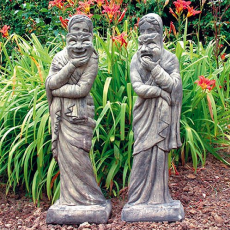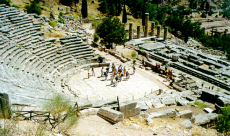
On the picture for this category you can see an image of two masks—one happy, one sad—and you’ve probably also seen this image used elsewhere to symbolise theatre or drama. Did you ever wonder what the origins of this symbol are? Most people know that the happy mask represents comedy, and the sad mask represents tragedy, as these are the two main theatrical genres. However, most people probably don’t know that these masks actually represent the Muses of comedy and tragedy, and that this symbol is one of many conventions of modern theatre which can trace its origins to Ancient Greece.
The Muses were goddesses of inspiration for literature, science and the arts, and were considered to be the source of the knowledge contained in the myths and poetry which had been passed down orally for centuries. The nine Muses were the daughters of Zeus, king of the gods, and Mnemosyne, the personification of Memory. The Romans adopted the idea of the Muses from the Greeks and assigned functions to each one. Thalia, whose name means ‘flourishing’, became the Muse of comedy and idyllic poetry, which portrayed country life. She was portrayed in statues and art as a joyous young woman, crowned with ivy and holding a comic mask in her hand. Sometimes she was also seen holding a bugle, or trumpet, which was used to amplify actor’s voices in ancient comedy. Melpomene’s name means ‘one who is melodious’, because she was originally the Muse of singing before becoming that of tragedy. She was portrayed holding a tragic mask and wearing buskins, the laced calf-length boots which tragic actors wore to appear taller on stage. Comic actors wore socks instead; to this day ‘Sock and Buskin’ is a way to refer to drama, and is the name of many dramatic societies.

Masks themselves served an important function in Ancient Greek drama. First it’s important to know that what developed into theatre began as a religious festival to honour Dionysus, another son of Zeus and the god of the grape harvest and wine making. Masks performed a ceremonial function in the worship of the god and in this festival, which included singing and dancing competitions, and the recital of poetry. Later, around 532 BC, these performances developed into theatre as we know it today, and the Dionysia festival in Athens became a dramatic competition. With their exaggerated facial features and expressions, masks were useful in drama to denote different characters. Greek playwrights never used more than three actors and they were all men. Masks allowed an actor to appear in many different roles including female characters. Another important part of ancient theatre, the chorus was a group of 12 to 15 individuals who represented one ‘character’, who commented on and reacted to the central action of the play. By all wearing the same mask, the chorus could more convincingly present one multi-voiced persona.
The first recorded actor was a man named Thespis, who is the origin of the word ‘Thespian’ to refer to actors. He won the competition in 534 BC and his prize was a goat! This is probably the origin of the word ‘tragedy,’ which means ‘goat-song’. The competition began with the sacrifice of a bull to purify the Theatre of Dionysus (pictured) where it was held. This huge space on the southern slope of the Acropolis could seat 17,000 people. First wooden, and later stone, seats were caved into the side of the hill surrounded a flattened terrace producing a ‘theatron’ or ‘watching place.’ The round performance space was called the ‘orchestra,’ a word we have preserved in a different context. From 465 BC a backdrop began to be used behind the orchestra, and this was known as a skênê—the origin of the modern word ‘scene.’
Images: http://www.garden-statues.com/images/D/melpomene-and-thalia-01-500.jpg
http://www2.cnr.edu/home/bmcmanus/delphitheater2.jpg

0 Comment:
Be the first one to comment on this article.